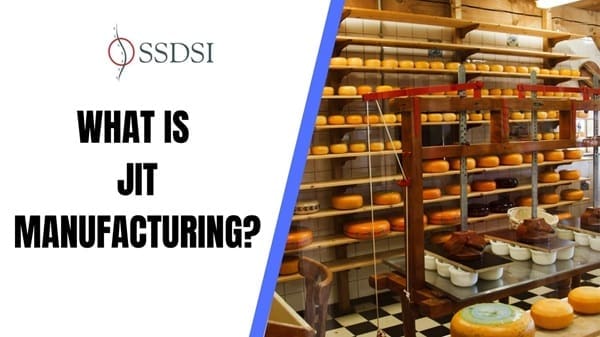Just-In-Time (JIT) manufacturing integrates various elements that work together to streamline production and achieve JIT goals. These components include human resources, production, purchasing, manufacturing, and organizational planning. They can be broadly categorized into the Toyota production system’s core areas: people, plants, and systems.
Table of contents
- What is Just-in-Time (JIT) Manufacturing?
- Misconceptions
- Historical Context and Evolution
- Principles of Just-in-Time (JIT) Manufacturing
- Practical Implementation of JIT
- Prerequisites for Successful JIT
- Elements of Just-in-Time (JIT) Manufacturing
- Benefits of JIT
- Limitations of Just-in-Time (JIT) Manufacturing
- Objectives of JIT
- JIT Concept in Practice
- Implementing JIT
- Final Words
- Related Articles
What is Just-in-Time (JIT) Manufacturing?
JIT manufacturing, as originally intended, ensures that production occurs only as needed when needed, and in the required quantities.
This philosophy applies not only to manufacturers but also to their suppliers. Properly implemented, JIT/Lean avoids warehousing by having suppliers produce materials precisely when required by the manufacturer, thus eliminating waste related to storage and associated resources.
Misconceptions
Many misconceptions surround Just-in-Time (JIT) manufacturing. A common but inadequate understanding is that JIT simply means having materials delivered just when needed. Another incorrect belief is that JIT manufacturers push inventory storage back to their suppliers.
While some companies have misapplied JIT principles in this manner, true JIT/Lean manufacturing seeks to eliminate all forms of waste throughout the production process and its support activities.
Historical Context and Evolution
The JIT/Lean system, initially developed by Taiichi Ohno in the 1950s, evolved from Henry Ford’s mass production methods. Ohno’s Toyota Production System (TPS) emphasized producing items only when needed, with suppliers delivering materials just in time for production. This efficiency led to the generic name “just-in-time.”
In 1990, the book The Machine That Changed the World by Jim Womack, Dan Jones, and Dan Roos popularized the term “Lean production.” Lean production, derived from TPS, focuses on using fewer resources—manpower, investment, engineering, inventory, and facilities—than traditional mass production systems. Over time, “Lean” has become synonymous with JIT and has been adapted across various industries.
Principles of Just-in-Time (JIT) Manufacturing
JIT/Lean manufacturing revolves around producing only what is needed, when it is needed, and in the necessary quantities. This approach minimizes waste and aligns production closely with actual demand, rather than forecasts. Traditional mass production often leads to overproduction, excess inventory, and associated costs, which JIT/Lean seeks to eliminate.
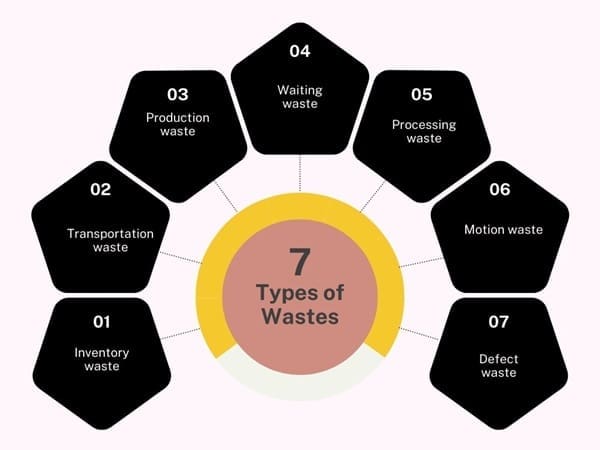
JIT/Lean emphasizes continuous improvement and the elimination of waste, which includes:
- Inventory waste: Reducing excess raw materials, work-in-process, and finished goods.
- Transportation waste: Minimizing unnecessary movement of materials and products.
- Production waste: Preventing overproduction and defects.
- Waiting for waste: Reducing idle time for workers and machines.
- Processing waste: Streamlining processes to avoid unnecessary steps.
- Motion waste: Minimizing movement of people and equipment.
- Defect waste: Reducing errors and rework.
Practical Implementation of JIT
In a motion sensor manufacturing company, each worker carries out one of five discrete processes. In a traditional setup, warehouses store materials and release them according to a schedule, potentially causing inefficiencies and waste.
Under JIT, suppliers supply materials directly to the production line as needed, eliminating the need for warehousing and reducing spoilage, obsolescence, and other related problems. This streamlined approach ensures efficient use of resources, contributing to the overall effectiveness of the manufacturing process.
Prerequisites for Successful JIT
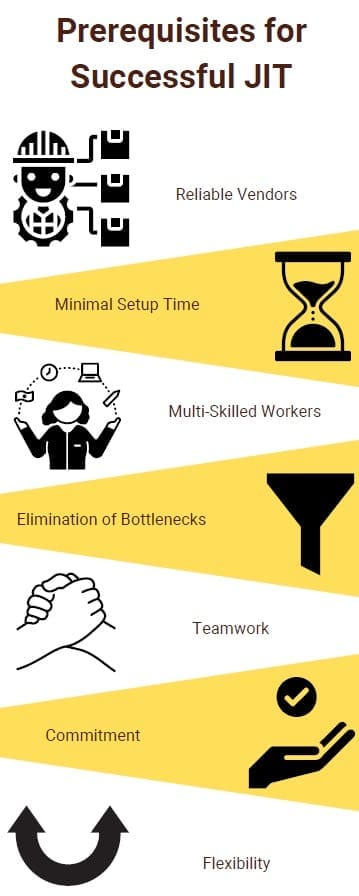
- Reliable Vendors: Suppliers must consistently provide materials of the required quality and quantity at the right time.
- Minimal Setup Time: Reducing machine setup times to facilitate quick transitions between production runs.
- Multi-Skilled Workers: Training workers in multiple skills to increase flexibility and efficiency.
- Elimination of Bottlenecks: Identifying and addressing production bottlenecks to ensure smooth operations.
- Teamwork: Fostering a collaborative environment where everyone works towards common goals.
- Commitment: Ensuring commitment from all levels of the organization to embrace and sustain JIT/Lean principles.
- Flexibility: Maintaining flexibility in plant layout, equipment, workforce, and production decisions to adapt to changing demands.
Elements of Just-in-Time (JIT) Manufacturing

JIT manufacturing comprises several interrelated components that must work in harmony to achieve the system’s goals. These components can be categorized into three main areas: People, Plants, and Systems.
People Involvement
- Support and Agreement: Critical to JIT’s success is securing the support and agreement of all stakeholders, including stockholders, labour organizations, management, and government bodies. Involving these groups reduces implementation time and effort and minimizes potential issues.
- Stockholders: Focus on long-term profit realization and reinvest short-term earnings to finance necessary changes and investments.
- Labour Organizations: Inform and involve all employees and unions to gain support and remove implementation barriers. Good labour relations are essential, as JIT can increase worker stress.
- Management: All levels of management must support and exemplify continuous improvement.
- Government: Support through tax and financial incentives can motivate companies to innovate and share the financial burden of JIT implementation.
Plants
- Plant Layout: Designed for maximum worker flexibility, arranged by-product rather than process. Multi-function workers are trained to perform various tasks.
- Demand-Pull Production: Actual demand drives production, ensuring the production of only necessary quantities at the right time.
- Kanban: A signalling system using cards or tags to manage the flow of materials and ensure synchronization of production processes.
- Self-Inspection: Each employee inspects their work to ensure quality, catching and correcting mistakes at the source.
- Continuous Improvement: Focus on constant improvement in all areas of production. Continuously raise goals and standards within reasonable and achievable limits.
Systems
- Material Requirements Planning (MRP) and Manufacturing Resource Planning (MRP II): Computer-based systems that manage materials and financial resources, ensuring efficient planning and coordination of production activities.
- Total Quality Control: Emphasizes producing quality products correctly the first time, reducing the need for inventory and rework, and aligning with JIT’s goals of waste elimination.
Also See: Lean Six Sigma Certification Programs, Sacramento, California
Benefits of JIT
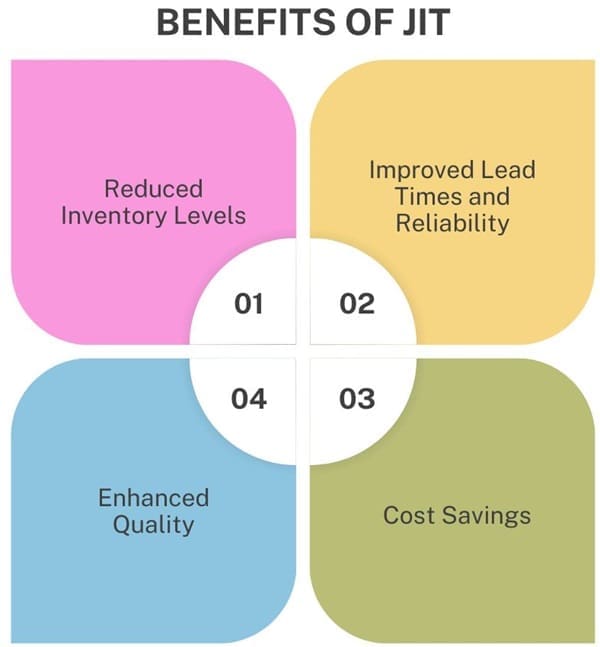
- Reduced Inventory Levels: Produce only what’s needed to minimize investments in inventory.
- Improved Lead Times and Reliability: Shorten delivery lead times and enhance reliability, reducing safety stock requirements.
- Enhanced Quality: Small order quantities make quality issues easier to identify and fix, fostering a culture of quality consciousness.
- Cost Savings: Lower factory space needs, reduced scrap and rework, less paperwork, and direct material cost reductions through bulk purchases.
Limitations of Just-in-Time (JIT) Manufacturing
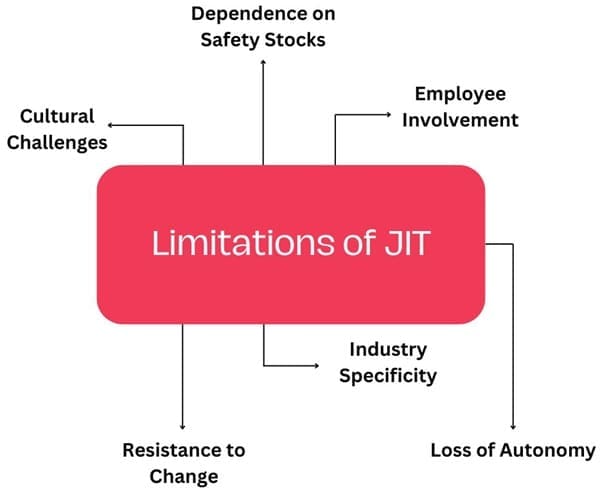
- Cultural Challenges: Success may depend on cultural factors, which can be difficult to change.
- Dependence on Safety Stocks: Traditional reliance on safety stocks can conflict with JIT principles.
- Employee Involvement: Western notions of worker empowerment may not align with JIT’s collaborative approach.
- Loss of Autonomy: Reduced cycle times and strict production methods can increase worker stress and reduce flexibility.
- Industry Specificity: JIT may be more suited to certain industries, particularly those focused on craftsmanship.
- Resistance to Change: Significant organizational changes can lead to resistance due to fear and anxiety among employees.
Objectives of JIT
- Enhanced Competitiveness: Enable firms to adapt and innovate, maintaining a competitive edge.
- Increased Efficiency: Boost productivity while minimizing production costs.
- Waste Reduction: Eliminate unnecessary materials, time, and effort in the production process.
JIT Concept in Practice
JIT aims to smooth material flow from suppliers to customers, speeding up manufacturing. Key objectives include:
- Improving customer responsiveness.
- Enhancing communication between departments and suppliers.
- Increasing flexibility.
- Achieving higher quality.
- Reducing product costs.
Implementing JIT
- System Integration: Incorporate JIT into ERP systems to manage production effectively.
- Environmental Adaptation: Create a JIT-friendly environment to support control techniques.
- Continuous Improvement: Pursue ongoing enhancements to processes and systems.
Final Words
JIT manufacturing, with its focus on efficiency and waste reduction, provides a competitive edge by aligning production closely with actual demand.
While the implementation of JIT can be challenging due to cultural and operational differences, its benefits in terms of reduced costs, improved quality, and increased flexibility make it a valuable strategy for modern manufacturing organizations.

About Six Sigma Development Solutions, Inc.
Six Sigma Development Solutions, Inc. offers onsite, public, and virtual Lean Six Sigma certification training. We are an Accredited Training Organization by the IASSC (International Association of Six Sigma Certification). We offer Lean Six Sigma Green Belt, Black Belt, and Yellow Belt, as well as LEAN certifications.
Book a Call and Let us know how we can help meet your training needs.

